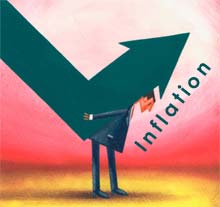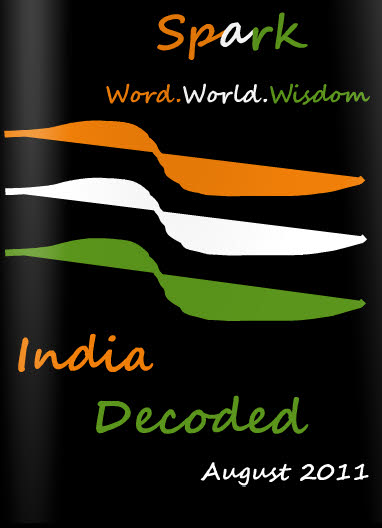by Viswanathan Subramanian
[box]Inflation. We come across the word ever so often in our day to day lives. But have you always been left with a vague understanding of what inflation is and how it works? Then this tutorial is for you. Viswanathan Subramanian demystifies this important economic indicator that is linked in a big way to your hard-earned money.[/box]No other macroeconomic topic is as intensively current as ‘inflation’. In our day to day lives, inflation is an ever-present influence on our lifestyles and our cost of living.
While it remains one of the oft-discussed topics as far as economies world over are concerned, it also needs to be mentioned that many of us are not aware about the exact nature of inflation and nuances of how it really works.
Here’s an attempt to demystify this important economic indicator that is linked in a big way to your hard-earned money.
Understanding Inflation
First, let’s understand inflation. Inflation is the rise in general level of prices of goods and services in an economy over a period of time.
 One can often encounter commonplace discussions like these among two to three generations, including a grandfather, father and son. Father can be heard quoting to his son: “I used to buy ‘…’ measures of rice for one anaa ! (roughly 6 Paise in today’s parlance). Now you are buying one kg of rice for Rs 40!” “I travelled 8 km for 20 Paise in those days; now you have to shell out Rs 7.” “I bought this plot for Rs 12000 but today it quotes at Rs 1 Crore!” Such statements are endless. All these are instances of inflation running through every moment of our life. It is peculiar that inflation is nothing but a rate of increase only. In that sense, inflation is positive but its effect on the public is negative.
One can often encounter commonplace discussions like these among two to three generations, including a grandfather, father and son. Father can be heard quoting to his son: “I used to buy ‘…’ measures of rice for one anaa ! (roughly 6 Paise in today’s parlance). Now you are buying one kg of rice for Rs 40!” “I travelled 8 km for 20 Paise in those days; now you have to shell out Rs 7.” “I bought this plot for Rs 12000 but today it quotes at Rs 1 Crore!” Such statements are endless. All these are instances of inflation running through every moment of our life. It is peculiar that inflation is nothing but a rate of increase only. In that sense, inflation is positive but its effect on the public is negative.
What is the origin of inflation?
When money exceeds supply of goods and services.
So, how exactly does inflation arise? One of the reasons could be because more money is chasing less merchandise, pushing up prices. Add to this, short supply of goods and services – this type of inflation is called demand-pull inflation.
In fact, when more money is left at the disposal of people, this drives or heats up demand and we call this overheating of the economy. Paper currency has lost its respectability ever since such currency got de-linked from Gold (called Gold Standard in universal parlance). Now the demon of paper currency dictates everything else. A paper with no substantive but nominal value rules over real things!
Overheating is fuelled by two factors:
a) Fiscal deficit – Government spending more money than what it earns as revenues from imposition of tax, sale of public sector unit shares etc.
b) Current Account deficit – when more imports rather than exports are made by our country. When imports exceed exports, it normally may lead to depreciation of the rupee and such weakened currency leads to an increase in rate of interest in the country, inviting more of foreign currency, say dollars, to flow into India. More of such dollars mean more rupees will get released into public, thereby increasing inflation.
These inflate prices as more money gathers around goods available in the market.
Unless there is adequate supply of goods, it is not possible to bring down inflation simply by using monetary tools like increase in rate of interest at which money is borrowed. In a scenario of increasing inflation, inflation is not entirely related to money supply alone. There are various other factors that can contribute to inflation:
- Prices of food products, non-food primary products and manufactured non-food products.
- Global commodity prices: Rising global commodity prices (like petrol or coal), amid a strong global economy, also contribute to an increase in inflation.
- Exchange Rate: Exchange Rate is the financial equation between currencies of two nations, say US dollar and Indian rupee. When Indian economy is more promising and the rate of interest in India rules higher than in U.S, there obviously is a rush of U.S dollars into India and in such a scenario, RBI has to release liquid rupees equivalent to such dollars into the Indian economy. Such a release of rupees has potential to drive up inflation.
- Rising labour costs: Increase in labour cost contributes ultimately to increase in price of manufactured output. Such an increase in price is inflation.
- Bad weather: Unseasonal rains post-monsoon can lead to a spike in vegetable prices, thus leading to higher inflation
When cost of goods continues to increase without any alternative available
Producers are sometimes able to pass on large share of input cost pressures to the consumers, if there is a strong public demand for manufactured goods. When people are ready to buy despite this increase in prices, inflation increases.
Inflation arising out of this is called Cost-Push inflation.
In India, demand-pull inflation is more common.
Ways of Controlling Inflation
There are various measures by which inflation can be controlled.
Improving supply-side response:
Here are some ways by which supply-side response can be improved. This will ensure that enough goods, particularly food products, meet demand.
- Higher storage capacity for grains
- Cold storage chains to manage supply side shocks in perishable produce
- Better management of waste in farm and allied activity
- Land consolidation, improving land quality, better seeds, irrigation, harvesting technologies and efficient routing of produce to final consumers.
Here are some ways to tackle demand-side response. These measures will help moderate demand.
- Increasing rate of interest on borrowings – called dear-money policy to moderate demand. This is done by the RBI from time to time.
- Increasing Cash Reserve ratio of Banks by RBI. When cash reserve is increased, the amount of cash that banks can lend is curtailed. To this extent, hot currency will not drive inflation.
The Final Word
Despite all theory and practice, inflation at best can only be contained or moderated but cannot be stopped. In other words, it’s only the rate of increase in prices that can be controlled but never the increase per se. As far as the situation in India is concerned, where inflation is always garnering attention for all the wrong reasons, the organised working sector has the Dearness Allowance tuned to any increase in inflation recognised through indices – Wholesale or Consumer Price Indices. However, the unorganised sector, which employs a huge number of people, just lies in waiting – looking forward to considerateness of their employers to not to deny them mercy-increases in emoluments, so that they can carry on with life amid mounting inflationary pressures.
Viswanathan Subramanian was a banker for over 35 years. In his new retired life, he loves poring over business newspapers and journals and making notes. Spirituality also interests him, and so a good number of Sri Ramana Maharishi’s and Jiddu Krishnamurthy’s books find space in his bookshelf. He is extremely passionate about movies and music too. You are sure to find some good old English movie DVDs and an enormous collection of old mp3 Hindi and Tamil songs at his place!
[button link=” https://sparkthemagazine.com/wp-content/uploads/2011/09/Spark-Sep2011.pdf” color=”red” newwindow=”yes”] Click here to download the September 2011 issue as a PDF.[/button] [button link=”http://issuu.com/sparkeditor/docs/spark-sep2011?mode=embed&layout=http%3A%2F%2Fskin.issuu.com%2Fv%2Fcolor%2Flayout.xml&backgroundColor=000000&showFlipBtn=true” color=”green” newwindow=”yes”] Click here to flip and read the issue like a magazine.[/button]
[facebook]Share[/facebook] [retweet]Tweet[/retweet]








